Geometrical disorder and steric exclusions in granular materials lead to an unexpectedly inhomogeneous distribution of contact forces. The inhomogeneous transmission of stresses was initially observed by means of photoelastic experiments with particles made of a birefringent material. A photoelastic image, readily reveals filaments of bright grains subjected to high loads against a background of dark zones composed of much less loaded grains. Such filamentary patterns of stresses inside grains are induced by strong contact forces and are known as force chains. The linear aspect of chains observed in most reported experiments reflects long-range ordering of grains of nearly the same size in a 2D geometry. But this linear aspect of strong force chains is more generally observed in simulations of arbitrary grain shapes and size distributions in 2D and 3D, in which a variety of other patterns such as arch-type chains are quite common.
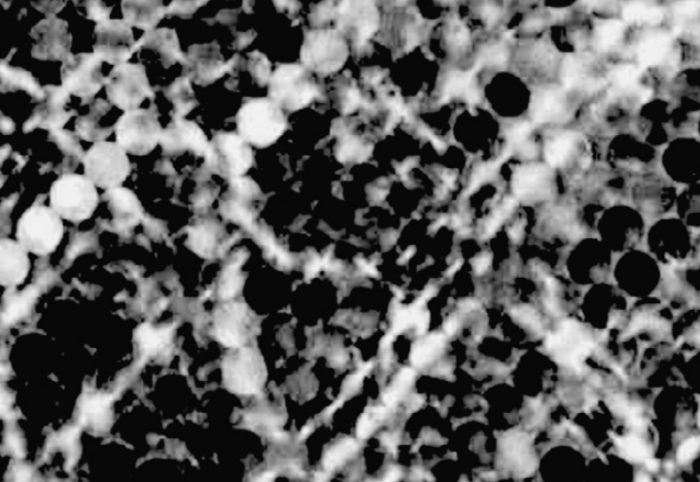
Stress chains in a photoelastic image of a packing of beads.
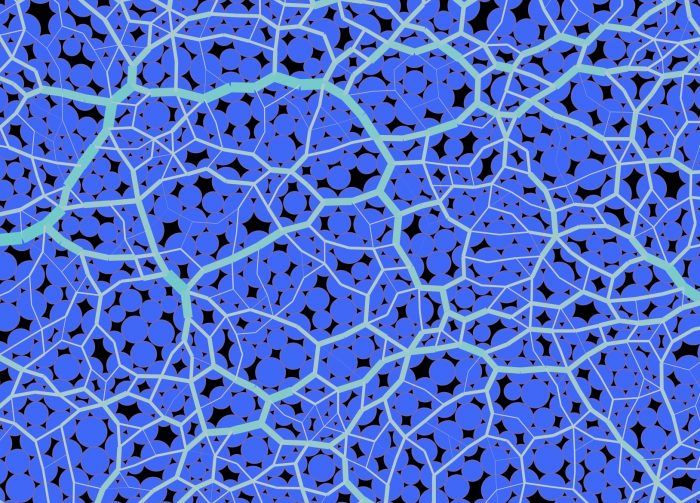
Force chains in a simulated packing of disks in 2D. Line thickness is proportional to normal force.
The forces were measured for the first time by using carbon paper to record normal force prints at the boundaries of a bead packing. They were found to have a nearly uniform probability density function (pdf) in the range of weak forces followed by an exponential falloff of strong forces. Similar force distributions were found by later experiments using contact area trace and by means of numerical simulations (see here). The data from simulations and experiments coincide every where within the available precision in exception to the range of vanishingly small forces, where the details of sample preparation matter. The solid line is the plot of a model introduced by Radjai (see here).
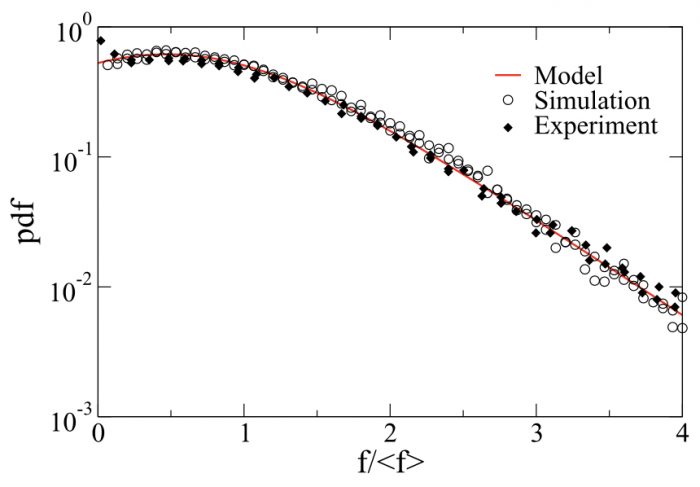
Probability density function of normalized forces obtained by Contact Dynamics simulations of Radjai et al, experiments of Mueth et al using carbon paper trace, and a theoretical model by Radjai.
Detailed analysis of sheared granular materials by Radjai et al provided evidence for the bimodal organization of the force network in well-defined weak and strong networks (see here) with the strong network contributing almost exclusively to the shear strength and weak forces acting mainly to prop strong force chains. All further investigations of force distributions have shown that the exponential distribution of strong forces is a robust feature of force distribution in granular media both in two and three dimensions. In contrast, the weak forces appear to be sensitive to the packing state resulting from the deformation history. In an isotropic packing state, the distribution shows a relatively small peak below the mean force, and the probability density of small forces does not fall to zero. The peak disappears in a sheared packing and the distribution of weak forces turns to a nearly decreasing power law. This is also what generally is observed in frictional packings composed of aspherical grains or with broad size distributions.
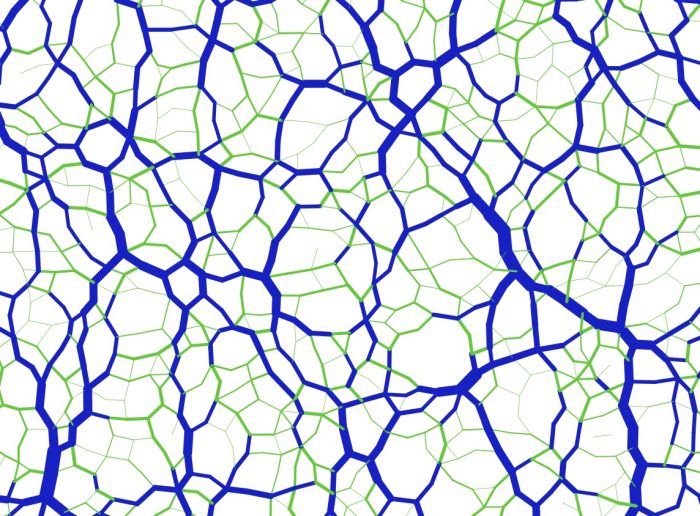
Weak (green) and strong (blue) forces in a 2D packing.
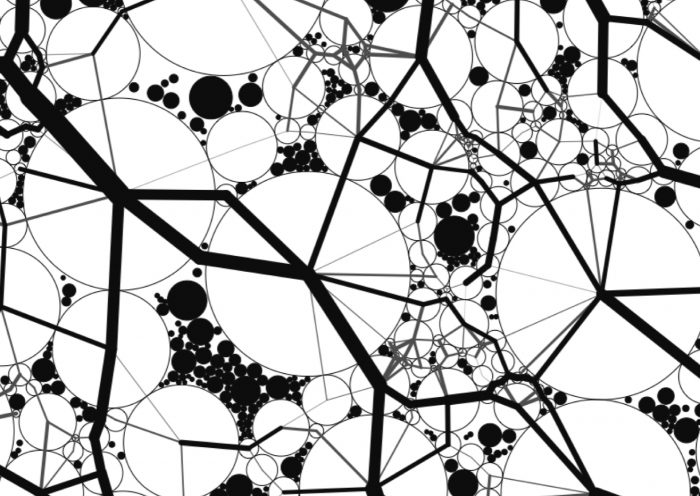
Multiscale force chains in a highly polydisperse 2D packing. Black particles are rattlers (excluded from the force network).
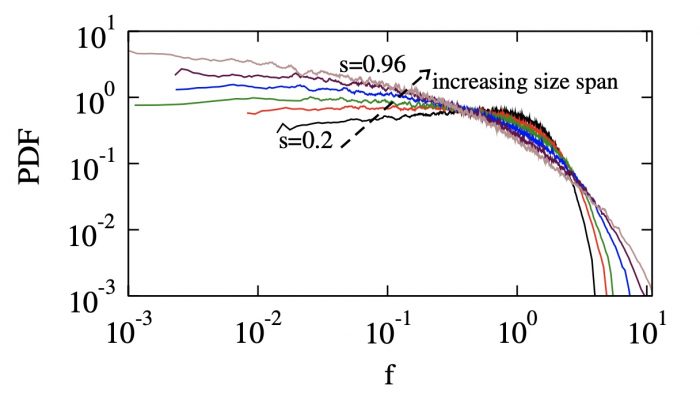
Probability density function of normal contact forces with increasing particle size span s.
The sensitivity of force probability density to packing states and grain characteristics indicates that it can be used as structural descriptor of granular materials, and it might even be more relevant to the rheology of granular materials than purely geometrical descriptors such as radial pair distributions. In this sense, a successful modeling approach may reveal the respective roles of disorder, steric exclusions (with the effect of constraining grain environments) and force balance in the rheological behavior of granular materials. The q-model was the first attempt in this direction. The forces are assumed to be scalar quantities that “propagate” from site to site (particles) along the links (contacts) of a regular network. The total incoming force w = f1 + f2 from the particles of a layer to each site is redistributed to the particles of the next layer according to a random process: f1′ = qw and f2′ = (1 − q)w where q is a random variable ∈[0,1]. It is further assumed that the incoming forces are not correlated so that P(f1, f2)= P(f1)P(f2) in analogy with ‘molecular chaos’ assumption in kinetic theory of gases. The q-model predicts that the force pdf converges to a purely exponential function P ( f ) = β exp(−β f) with the exponent β depending on the number of supporting contacts per grain. A typical value ≃ 1.5 is obtained by fitting the data points. This value is, however, almost independent of space dimension, which controls the number of contacts per grain, thus contradicting the q-model. The pdf of w is of the form P (w) = β^2 w exp(−β w) (being often confused with P ( f )). A common belief is that this model may apply to the components fx of the forces along a direction x in a truly disordered system. But the angular hindrances between the particles lead to a strong correlation of force components and thus the molecular chaos assumption does not hold. Later efforts to generalize this model to vectorial force balance have not led to analytical forms. But a statistical approach developed by Metzger et al provides a correct estimate of the force pdf by analyzing the local constraints and accounting for the density of states in a first-shell approximation (one grain with its contact neighbors).
It is worth mentioning the developments referring to the entropy of contact forces in a ‘virtual’ thermodynamics to rationalize the exponential distribution of strong forces as a consequence of the density of force states imposed by boundary stresses. Such an appealing analogy with the Maxwell–Boltzmann distribution of velocities does not recover the nonzero probability of vanishing forces, but it suggests that the exponential distribution of strong forces is not a decisive test for force models as it arises from a general statistical argument. Other routes have successfully been explored to obtain semi-analytical fits to the force pdf in isotropic dense packings. For example, a mathematical analysis was developed on the relationship between the force pdf’s and their directional components. This analysis indicates that, if the forces in q-model are the components of contact forces along the propagation direction, the resulting distribution for the normal forces is a Bessel function passing through the origin, and, in this respect, it does not correctly model the range of weak forces. But a linear combination of several functions provides a convenient fit to the data points.
A new force model was proposed by Radjai in 2015. This model is based on a force population balance, and it leads to an analytical expression of force probability density. The central idea that, in the presence of steric exclusions, a force may occur at a given contact depending on the availability of forces of a magnitude above that force in the neighboring contacts as well as smaller forces allowing for static equilibrium. This idea can be cast into an integral-differential equation, which has a simple analytical solution predicting an exponentially decreasing tail, a small peak the mean force and a nonzero force probability at zero force. This expression fits numerical and experimental data by adjusting a single free parameter.
Further reading:
Contact forces in a granular packing
Force transmission in a packing of pentagonal particles
Shear strength and force transmission in granular media with rolling resistance
Multiscale force networks in highly polydisperse granular media
Stress transmission in wet granular materials
Force transmission in dry and wet granular media
